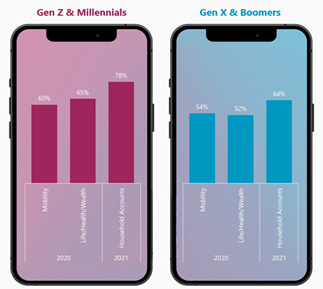Average auto use is only 4% of each day, yet a new vehicle purchase frequently costs 50% of someone’s annual income.[i] When you add in taxes, fuel, insurance, and maintenance, many people can’t make a logical case for ownership. This is especially true in urban areas, where mobility options are plentiful and on the rise. In spite of these facts, auto ownership is also on the rise. If we look at the complete mobility picture, auto insurance will remain relevant while at the same time non-traditional transportation insurance is going to begin to grow, particularly as people continue to use their vehicles to earn extra money via ride-sharing companies. This creates a need for “hybrid” P&C mobility products.
E-bikes, for example, are a rapidly-growing mobility option for those who wish to purchase a less expensive way to commute. They are also available through massive bike-share networks, such as Chicago’s Divvy system of bikes and e-bikes.
E-bikes aren’t the only mobility option that is on track for growth, but they make a good case in point. They check the boxes for trends that could disrupt auto use and auto insurance. They are highly economical. They are faster than traditional bikes (approximately 21% faster per trip).[ii] If you’re using them for a commute, you’re less likely to arrive at work exhausted and sweaty. They are easy on the environment. They give you some freedom to go where you wish to go without sticking to a public transit route. Shipping companies, such as UPS, are even considering e-bikes for last-mile delivery.
E-bikes have even been shown to encourage people to ride more, and since e-bikes use pedal-assist technology, the net effect could be that e-bike users improve their health.
Of course, there is a flip side to e-bikes that involves insurance. Due to their potential speed (20 mph), they are less safe than a traditional bike. Their components cost more to replace in an accident claim. Their riders may have less two-wheel experience because E-bikes are appealing to some riders that would not normally ride a traditional bike due to age, health, or hilly terrain.
Even though e-bikes aren’t going to displace vehicles anytime soon, P&C insurers need to grasp their potential impact, along with the impact of car-sharing, ridesharing, transit improvements, work-from-home lifestyles, and the use of personal vehicles for business use. Mobility is changing and insurance will need to shift to capture the opportunities it will create.
For several years now, Majesco has been tracking and understanding how we move.
In our previous Mobility research, we noted the significant change in automotive activity is resulting in companies outside insurance coalescing around a shift to the concept of “mobility.” From the decline in car ownership for the first time since 1960, to the rise of ride-hailing and car-sharing services, a plethora of transportation options continues to expand – hence the focus on mobility. In this year’s Consumer Research report, Majesco looked at the consumer trends with the greatest impact on P&C insurers. You can dig deeper into these shifts by reading, Your Insurance Customers: A Crystal Ball of Big Changes in a Small Window of Time. Today, we’re making a case for mobility. Does your organization grasp how the coming mobility shift requires insurers to rethink products and services that fit these new risks?
Mobility in motion
Let’s look at where mobility is today. According to the American Time Use Survey, the percentage of people traveling in 2020 dropped by 17 percentage points, to 67% from 84% in 2019[iii] – likely driven by the remote work environment.
The use of rideshare services like Uber and Lyft dropped when COVID hit in 2020 and continued to decline, especially among Gen X & Boomers. Gen Z & Millennials continue to value mobility as they use new mobility options like e-bikes or scooters or short-term rental of cars from a service like Zipcar or another person’s car through a platform like Turo or Getaround.
Figure 1: Mobility activity trends
However, the automobile is still important to Gen Z & Millennials. They bought and/or sold a vehicle at over twice the rate of Gen X & Boomers, with 42% indicating they bought or leased a car, 21% sold a car, and 28% either added a car or bought their first car.
Figure 2: Mobility activities in the past year
In the next three years, automobiles should see a resurgence. Gen Z & Millennials in particular will be buying/leasing new vehicles and expect to be driving more than they currently do. This suggests two key potential shifts in auto insurance:
- First, the popular UBI-based insurance, which has seen growth due to COVID and remote work, may need to be adapted beyond just miles driven, to consider where and how to manage customer value and cost expectations.
- Second, the surge in buying new vehicles that have embedded, sophisticated technologies for telematics, sensors, and driverless functions, as well as innovative services, will likely create demand for embedded insurance in the purchase from the manufacturer. Increasingly, auto manufacturers either offer or are soon to offer embedded insurance. This shift requires insurers to offer similar coverages and services to retain customers or to partner with automobile manufacturers.
Regardless, the growth in new, technically sophisticated vehicles will require insurers to move beyond both traditional auto and UBI insurance products to new options that reflect lifestyles and behaviors, and are inclusive of value-added services.
Furthermore, with the easing of COVID restrictions, the pent-up demand for travel, especially within the U.S., is expected to grow. This offers a market opportunity to provide on-demand coverage for specific events, trips, mobility options, and bundled packages, such as American Family’s Road Trip Accident Accommodations Coverage. Furthermore, the rise of travel via planes and the challenges with airlines has seen an increase in demand for travel insurance.
Figure 3: Mobility expectations in the next 3 years
How will customers buy the mobility insurance they need?
From a product perspective, customers expect an expanding array of products to meet their changing behaviors, needs, and expectations. The Gen Z & Millennial generation is vastly different than the older generation, both in terms of their lifestyle but also their digital savvy and life journey. However, both still want digital and multi-channel options as well as a growing array of value-added services.
This presents significant implications as well as opportunities for insurers, all based on how rapidly they plan and execute against them. Many InsurTech start-ups and incumbent insurer greenfields are specifically targeting the Gen Z & Millennial generation with new, innovative products, value-added services, and experiences that are vastly different than most traditional insurers.
Majesco analyzed consumer data against insurer data from a joint research project with PIMA in 2020 for program business and affinity plans for three insurance segments (Life/Heath/Accident, Auto, and Home/Renter). You can see more on Life/Health/Accident and Home/Renter by downloading the Consumer Research report. Our analysis was aimed at figuring out if insurers are aligned to customer sentiment regarding how they would like to buy auto/mobility insurance.
Product and Channel Alignment
The prime opportunities lie in areas where there is high customer interest in a particular insurance channel, and insurers are ready to move into that channel. That is represented in the top right quadrant in figure 4. However, the greatest breadth of opportunity lies in areas where customers are ready to purchase through a particular channel, but insurers aren’t prepared to utilize that channel. That is represented by the top left quadrant in figure 4.
Figure 4: Auto insurance channel alignment/misalignment
Customer Experience
There is also considerable insurer-customer misalignment in the customer experience. Both generation segments use websites at similar levels for managing insurance, finance, and lifestyle products and services. However, insurance falls woefully behind in giving customers the ability to manage their products and services with mobile apps. This is especially concerning with Gen Z & Millennials, whose use of apps is 21 and 31 percentage points higher for finance and lifestyle products and services, respectively. These are gaps that must be closed by insurers.
Figure 5: Use of digital tools to manage accounts
A recent Carrier Management article noted how even people who were previously averse to using technology for everyday tasks have embraced it, citing an AARP study that found the percentage of U.S. adults over 50 years old (Gen X & Boomer segment) using a smartphone to make financial transactions rose to 53% in 2020, up from 37% from 2019.[iv]
In search of a holistic solution
Insurance is headed in a direction where new products, such as the kind that will cover all aspects of mobility, must be sold through completely new types of channels that fit with customer experience preferences.
Zurich Group Chief Claims Officer, Ian Thompson, said recently that “the pre-pandemic era was overly-focused on building an ‘app’ through which customers would have to engage.” Today the focus is on creating a holistic experience across different products, services, and channels. As we noted in last year’s consumer research report, the holistic experience was strongly desired by the younger generation, while of interest by the older generation in certain areas. The 2021 data indicates for both generational groups this is still strong (Figure 6) and growing even stronger compared to last year (Figure 7. Note: The 2021 “Household Accounts” figures represent the average interest across all categories in Figure 6).
Figure 6: Customer interest in a holistic solution to manage all of their accounts
Figure 7: Increased interest in a holistic solution, 2021 vs 2020
If we take both of these needs into account (integrated account solutions and holistic insurance solutions), we see that customers are asking for the smartest and fastest ways to keep them completely covered. They want insurance to be included in holistic account management solutions.
What does this kind of solution look like?
Our best option is to look at mobility insurance through the eyes of a customer. If a customer could choose the ideal insurance experience across all of their transportation options, how might it work?
Ideally, a holistic mobility insurance experience would be low-touch. In today’s digital world, it is possible for a cell phone to know whether it is moving by rail, bike, car, or foot. With UBI on the rise, and advanced, real-time data analysis, perhaps commuters could simply be covered and charged, based on their actual movement. This would fit their desire to receive pricing that is aligned with experience.
Insurance purchase could happen at one of many junctures in life; the purchase of a car, the purchase of a bike, or via a QR code on an ad at their favorite coffee shop. Claims could be app-based or auto-generated communications. Customer service could happen through text or by phone. Value-added services like reminders or travel alerts could keep customers safe. (e.g. “There is an 85% chance of heavy rain today.”)
The key is flexibility. Wherever mobility moves, insurers move with it. This requires insurers to move now.
Customer needs and expectations are dramatically different now. The accelerated pace of digital expectations is significantly different. The access to and use of data are very different. Channel and partner options are exponentially different. The business operating model and technology of the past will not support success for today and the future.
Opportunity exists for those who shift their operating model and technology to meet the customer on their terms.
Ask yourself:
- Are you ready for a greater focus on customer-driven digital transformation?
- Does your technology accelerate your digital transformation?
- Can you utilize digital in your bid to become a competitive and relevant insurance leader and achieve the profitable growth that comes with it?
- What specific plans can you take to improve your odds of success?
To prepare yourself for insurance customer trends, be sure to read, Your Insurance Customers: A Crystal Ball of Big Changes in a Small Window of Time. For Majesco’s related SMB trends research, download, A Rapidly-Changing SMB Landscape.
By Denise Garth
[i] 2018 Evolution of Mobility Study, 2019, Cox Automotive and Mobility
[ii] Bernsten, Sveinung, Lena Maines, Aleksander Langaker, Elling Bere, Physical activity when riding and electric assisted bicycle, International Journal of Behavioral Nutrition and Physical Activity, April 26, 2017.
[iii] “American Time Use Survey Summary,” op. cit.
[iv] French, David, “Digital Appeal Waning; Insurance Claimants Heading Back to Humans,” Carrier Management, November 21, 2021, https://www.carriermanagement.com/news/2021/11/21/229276.htm



























 Defense Lawyer’s Perspective: Connecting Insurers, Promoting Plaintiff-Style Solidarity
Defense Lawyer’s Perspective: Connecting Insurers, Promoting Plaintiff-Style Solidarity  Embroker CEO Reflects on Tech, Insurance Journey
Embroker CEO Reflects on Tech, Insurance Journey  California Commissioner Announces Regulation to Enable the Use of Modeling in Rates
California Commissioner Announces Regulation to Enable the Use of Modeling in Rates  Insurance Carrier Employees Are Bored; Most Boring Rankings Published
Insurance Carrier Employees Are Bored; Most Boring Rankings Published 



